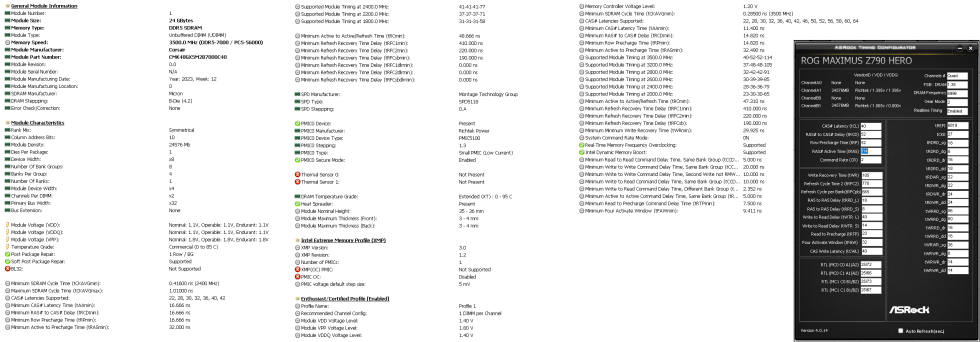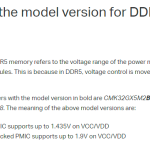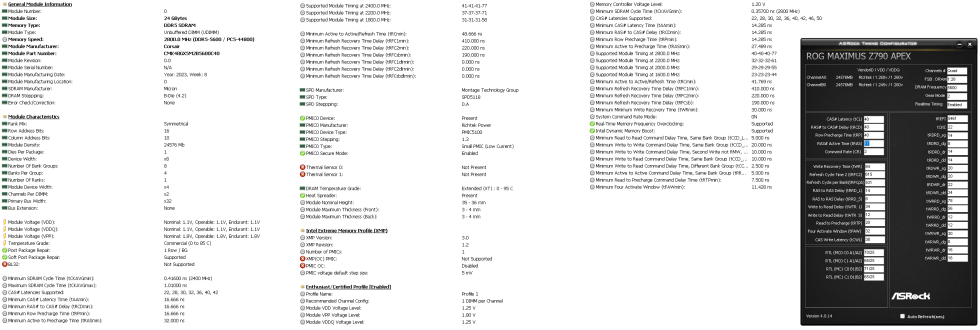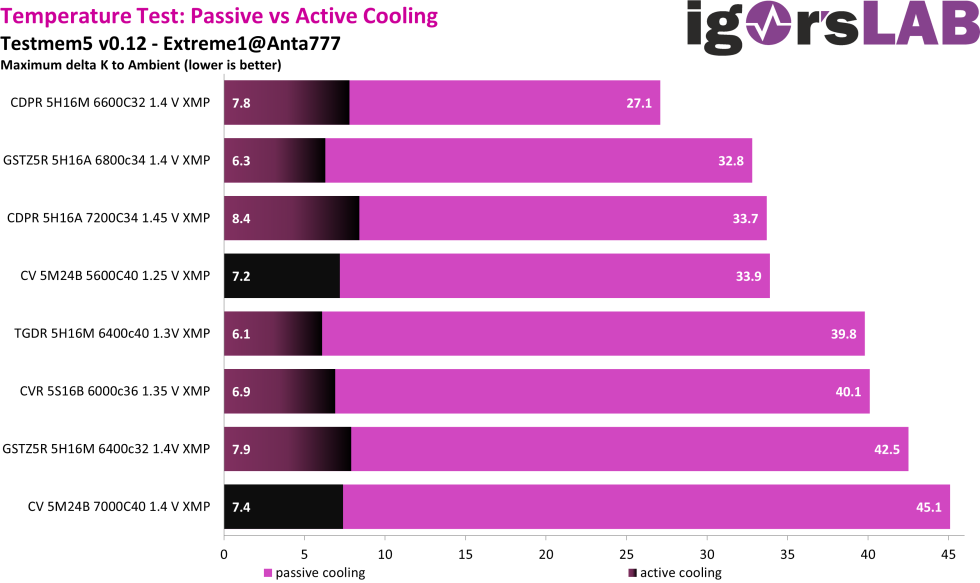SPD information
When we read out the SPD, we of course first find the kit’s product number again with the specified clock rate of DDR5-7000 or 5600. Below that, it gets interesting, because besides manufacturer Micron, the stepping is stored here as “B”. Further down we also find the so far rather unusual capacity of 24576 Mbit, which results in Micron 24 Gbit RevB as the IC designation – Micron doesn’t use -Die here like other manufacturers, but Rev as a prefix for the stepping.
The number of bank groups and the bit organization is unchanged to previous 16 Gbit ICs, only the memory capacity is increased by 50%. According to JEDEC, the dies are intended for operation at 1.1 V VDD, 1.1 V VDDQ and 1.8 V VPP, but at only 2400 MHz or DDR5-4800. This is rather unusual for new DDR5 dies, since many other second generation ICs are already specified for DDR5-5600 according to JEDEC. Unfortunately, the new ICs themselves still don’t have any temperature sensors.
The installed PMIC is of type PMIC5100 and a make of Richtek, but it is limited to a maximum of 1.435 V VDD/VDDQ. So far I have only seen Richtek PMICs without this limit. Recently you can’t rely on the manufacturer alone if you are looking for modules with an unlocked PMIC. By the way, Corsair’s information on the website is somewhat misleading, since “Overclocked PMIC” is listed here. However, the version limited to 1.435 V is meant and unlocked PMICs would be listed here as “Extreme overclocked PMIC”.
One has to be aware of this not necessarily intuitive naming. Instead of using terms like “Overclocked” and “Extreme Overclocked” or even “Locked” and “Unlocked”, it would be best if the voltage limit of the PMIC for VDD/VDDQ would be specified transparently, e.g. “PMIC VDD/VDDQ Limit: 1.435 V” or “PMIC VDD/VDDQ Limit: 1.9 V” – this wouldn’t sound as snappy, but it would be unmistakable and reliable. But enough about the voltage converter.
The SPD is a SPD5118 type from Montage Technology, which also integrates the temperature sensor. The height of the modules is also still stored in the SPD with 35 – 36 mm, which agrees with our measurement and is rather conservatively dimensioned, considering that approx. 2 mm of contact surfaces still disappear in the DIMM slot.
Finally, only the XMP profile remains, which I loaded completely with the XMP II option of the Asus Maximus Z790 Hero motherboard – including tWR, tRFC2, tRFCpb and VDD2 (MC Voltage). Here, 1.4 V VDD/VDDQ, 1.8 V VPP, 1.2 V VDD2 (MC Voltage) are stored for the voltages and tCL 40, tRCD 52, tRP 52, tRAS 114, tRFC2 770, tRFCpb 665, tWR 105 for the timings for the 7000 Mbps clock rate. There is no further XMP profile or EXPO profile.
The SPD of the 5600 SKU is largely identical, except for the XMP profile. Here, only 1.25 V VDD/VDDQ is stored for DDR5-5600 and tCL 40, tRCD 40, tRP 40, tRAS 77, tWR 84, tRFC2 615 and tRFCpb 531 as timings.
Heatsink test
As usual, we continue to test the cooling solution of the RAM modules and how much thermal potential is available for overclocking accordingly. Implicitly, this of course also tests whether a kit even survives the stress test in XMP mode without becoming unstable – yes, that also happens!
With the stress test Testmem5 v0.12 and the profile “Extreme1@Anta777” and without a slot distance between the modules, the highest possible heat load is generated. Together with another temperature sensor on the testbench, the delta to the ambient temperature is determined, once passively cooled and once actively cooled with a 120 mm fan directly on top of the modules and blowing down at 2000 rpm.
The Vengeance coolers without RGB show passably in the heatsink test, even with 1.4 V VDD/VDDQ and the new ICs. 45 Kelvin above the ambient temperature in passive mode is relatively warm, but even with a hypothetical air temperature of about 30 °C inside a PC case, we would still be below the JEDEC-specified 85 °C maximum temperature for DDR5. At only 1.25 V, the 5600 SKU is a good 10 K cooler in passive mode, but when compared to the other kits, the rather spartan cooler design of the Vengeance modules becomes apparent in the results. Due to their relatively slim and low profile, the modules benefit even more from active fresh air supply, which is almost always present in some form in practice.
For better clarity, the manufacturers and product names of the RAM kits have been abbreviated as follows:
- CDPR: Corsair Dominator Platinum RGB
- TGDR: Teamgroup DELTA RGB
- CV: Corsair Vengeance
- CVR: Corsair Vengeance RGB
- GSTZ5R: G.Skill Trident Z5 RGB







































12 Antworten
Kommentar
Lade neue Kommentare
Veteran
Urgestein
Veteran
Urgestein
Veteran
Veteran
Urgestein
Urgestein
Urgestein
Mitglied
Veteran
Neuling
Alle Kommentare lesen unter igor´sLAB Community →